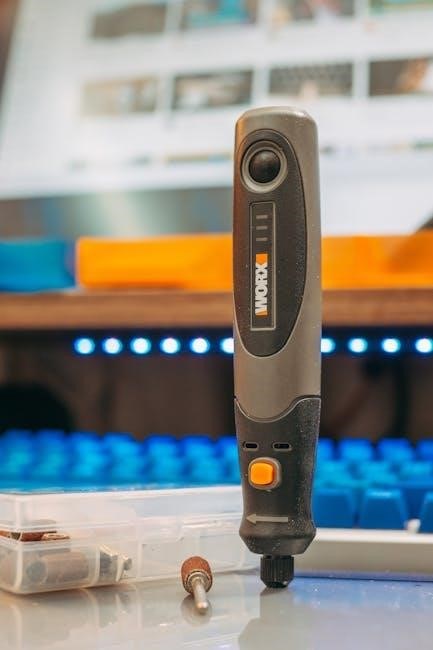
rotary tool accessories guide pdf
Rotary Tool Accessories Guide: A Comprehensive Overview
Access a wealth of PDF resources from manufacturers like Dremel and WEN, offering detailed guides for rotary tool accessories, ensuring safe and effective usage.
Rotary tools are incredibly versatile power tools, capable of performing a multitude of tasks – from cutting, grinding, and polishing to sanding, carving, and more. Their adaptability stems from the wide array of accessories available. Understanding these accessories is crucial for maximizing the tool’s potential.
Manufacturers like Dremel, WEN, and Hyper Tough provide comprehensive accessory guides, often available as PDF downloads. These guides detail each accessory’s intended use, compatible materials, and safety precautions; Accessing these resources – directly from the official websites – is highly recommended before beginning any project. They ensure you select the correct accessory for the job, promoting both efficiency and safety.
Proper accessory selection, informed by these guides, prevents damage to both the tool and the workpiece, extending the lifespan of your rotary tool and achieving professional results.
Understanding Rotary Tool Compatibility
Ensuring accessory compatibility is paramount for safe and effective operation. While many rotary tool accessories adhere to standard shank sizes, variations exist. PDF guides from manufacturers like Dremel explicitly outline compatibility charts, detailing which accessories work with specific tool models.
Dremel’s FortiFlex accessories, for example, are designed for compatibility with their multi-tool systems. Always consult the accessory guide before use, especially when using accessories from different brands. Ignoring compatibility can lead to improper fitting, increased vibration, and potential tool damage.
These guides also clarify shank size requirements and the use of mandrel systems for specialized accessories, guaranteeing a secure and efficient connection.
Types of Rotary Tool Accessories

Rotary tool accessories encompass a vast array, categorized by function. PDF guides detail these, including cutting accessories like wheels and blades, sanding & polishing accessories – wheels, drums, and pads – and grinding & sharpening accessories such as bits and stones.

Further categories include carving & engraving accessories (bits and cutters), polishing & buffing accessories (wheels and compounds), and drilling & routing accessories (bits and routing tools). Specialty accessories, like fiberglass and high-speed steel cutting wheels, are also covered.
Manufacturer guides, such as those from Dremel, provide detailed descriptions and recommended applications for each type, aiding in informed selection.
Cutting Accessories
Cutting accessories, detailed in rotary tool accessory guides (PDF format often available), are designed for diverse materials. These include cut-off wheels – ideal for metal, plastic, and wood – and spiral cutting bits for intricate designs. PDF resources emphasize selecting the correct wheel grit and material for the task.
Fiberglass cutting wheels, highlighted in some guides, offer precision, while high-speed steel cutting wheels provide durability. Proper accessory selection, as outlined in manufacturer PDFs, ensures clean cuts and prevents damage. Always consult the guide for speed settings and safety precautions when using these tools.
Sanding & Polishing Accessories
Sanding & polishing accessories, comprehensively covered in rotary tool accessory guides (often available as PDFs), transform surfaces. These include sanding drums, discs, and flap wheels for material removal and smoothing. PDF resources detail grit selection – coarser grits for rapid removal, finer grits for polishing.

Polishing wheels and compounds, also detailed in these guides, restore shine to metal, plastic, and wood. Manufacturer PDFs emphasize using appropriate speeds and applying consistent pressure. Understanding accessory compatibility, as shown in the guide, is crucial for optimal results and preventing damage to both the workpiece and the tool.
Grinding & Sharpening Accessories
Grinding & sharpening accessories are extensively detailed within rotary tool accessory guides, frequently found as downloadable PDFs. These guides showcase grinding stones, diamond wheels, and sharpening attachments for various materials. PDF resources emphasize selecting the correct abrasive grain for the task – coarser for rapid material removal, finer for precision sharpening.
Manufacturer PDFs provide crucial safety information regarding speed settings and proper technique. They also illustrate how to use these accessories for tasks like sharpening blades, removing rust, and shaping metal. Understanding compatibility, as outlined in the guide, ensures optimal performance and prevents accessory failure.
Stone & Concrete Cutting/Grinding Bits
Rotary tool accessory guides, often available as PDF downloads, dedicate sections to bits designed for stone and concrete. These guides detail diamond-coated bits for cutting tile, brick, and concrete, alongside abrasive grinding stones for smoothing rough surfaces. PDF documentation stresses the importance of using water to cool the bit and reduce dust during operation.
Manufacturer PDFs highlight specific bit shapes – segmented, continuous rim – and their ideal applications. They also provide guidance on selecting the appropriate speed and pressure. Safety precautions within the guide emphasize wearing dust masks and eye protection when working with concrete and stone materials.
Carving & Engraving Accessories
Rotary tool accessory guides, frequently found as downloadable PDFs, extensively cover carving and engraving attachments. These guides showcase a diverse range of bits, from conical and ball-shaped for detailed wood carving to specialized cutters for intricate metal engraving. PDF documentation often includes charts matching bit shapes to specific carving techniques.
Manufacturer PDFs detail material compatibility – which bits are best suited for wood, plastic, or metal. They also emphasize the importance of using appropriate speeds and light pressure to prevent breakage. Safety sections within the guide stress the need for eye protection and secure workpiece clamping.
Wood Carving Bits – Shapes & Uses
Rotary tool accessory guides, often available as PDF downloads, illustrate various wood carving bit shapes and their applications. Conical bits excel at creating rounded details and hollows, while ball-shaped bits are ideal for sculpting curves and contours. Flame-shaped bits are useful for smoothing and shading. PDFs detail how to select the correct bit for different wood types.
These guides emphasize starting with softer woods like pine for practice. They also highlight the importance of using multiple bits for complex projects. Safety sections within the PDFs warn against excessive pressure and recommend using dust extraction to maintain visibility.
Metal Engraving Cutters
Rotary tool accessory guides, frequently found as downloadable PDFs, showcase a range of metal engraving cutters. These cutters, often with carbide or high-speed steel tips, are designed for precision work on metals like aluminum, brass, and steel. PDFs illustrate different cutter profiles – V-shaped for outlining, round for creating grooves, and flat for removing material.
Manufacturer guides, such as those from Dremel, emphasize the need for lower speeds when engraving metal to prevent overheating and damage. They also recommend using lubrication to reduce friction and improve cut quality. Safety sections within the PDFs stress the importance of wearing eye protection.
Polishing & Buffing Accessories
Rotary tool accessory guides, often available as PDF downloads, detail a variety of polishing and buffing accessories. These include polishing wheels made from felt, cloth, or rubber, alongside compounds ranging from coarse to fine grits. PDF documentation from brands like Dremel explains how to select the appropriate wheel and compound based on the material being polished – metal, plastic, or wood.
These guides emphasize the importance of applying polishing compound sparingly and using moderate speeds. Safety sections within the PDFs highlight the need for eye protection and avoiding excessive pressure, which can cause the wheel to melt or shatter.
Polishing Wheels & Compounds
Rotary tool accessory guides in PDF format thoroughly cover polishing wheels and compounds. They detail various wheel materials – felt for fine polishing, cloth for general use, and rubber for blending. PDFs from manufacturers like Dremel categorize compounds by abrasive level, from coarse for removing scratches to fine for achieving a high gloss.
These guides explain how to match wheel type and compound grit to the workpiece material. They also emphasize proper application techniques, advising users to apply compound sparingly and maintain consistent speed. Safety sections within the PDFs warn against excessive pressure and the importance of eye protection.
Drilling & Routing Accessories
Rotary tool accessory guides, often available as PDF downloads, dedicate significant sections to drilling and routing bits. These guides detail bit materials – high-speed steel for metal, carbide for harder materials – and their corresponding applications. PDFs illustrate various drill bit shapes, including twist, spade, and Forstner bits, explaining their optimal uses.
Routing bits are categorized by profile – straight, V-groove, roundover – with guides demonstrating how to achieve different edge effects. Safety instructions within the PDFs stress the importance of secure workpiece clamping and appropriate speed settings. They also cover proper bit storage to maintain sharpness and longevity.
Drill Bits for Various Materials
Rotary tool accessory guides, frequently found as PDFs, provide detailed charts matching drill bit types to materials. These guides explain that high-speed steel (HSS) bits are suitable for wood, plastic, and softer metals, while carbide-tipped bits excel in harder materials like ceramic tile and glass.
PDFs often illustrate specialized bits – thin-wall bits for intricate work, step bits for varying hole sizes – and their specific applications. They emphasize using lower speeds for harder materials and lubricating bits during metal drilling. Safety sections within the guides warn against forcing the bit and recommend proper eye protection.
Routing Bits for Edge Profiling
Rotary tool accessory guides, often available as PDF downloads, detail routing bit profiles – round-over, V-groove, and flush trim – and their ideal uses for edge detailing. These guides emphasize the importance of multiple passes with light pressure, preventing tear-out, especially in wood.
PDF resources illustrate proper bit direction and suggest appropriate speeds for different wood types. They also cover safety precautions, like securing the workpiece and wearing eye protection. Many guides highlight compatibility with multi-tools using mandrel systems, expanding routing capabilities. Understanding bit shank sizes, detailed in the PDFs, is crucial for proper fit.
Specialty Rotary Tool Accessories
Rotary tool accessory guides, frequently found as downloadable PDFs, showcase specialized attachments like fiberglass and high-speed steel cutting wheels. These PDFs detail applications – cutting tile, plastic, or metal – and emphasize safety protocols due to the brittle nature of these accessories.
Guides often include charts detailing appropriate speeds and recommended protective gear. They highlight the importance of inspecting for cracks before use, referencing the accessory inspection section. PDF resources also cover unique bits for specific tasks, like scoring glass or cleaning grout. Manufacturer guides (Dremel, WEN) provide compatibility information and usage tips.
Fiberglass Cutting Wheels
Rotary tool accessory guides, often available as PDF downloads, dedicate sections to fiberglass cutting wheels, emphasizing their fragility and required safety measures. These guides detail proper usage for cutting materials like tile, glass, and plastic, stressing the need for eye protection.
PDFs highlight the importance of avoiding side pressure and using a smooth, controlled cutting motion. They also cover inspection procedures – checking for cracks or damage before each use. Manufacturer guides (like Dremel’s accessory guide) specify compatible speeds and recommend using a steady hand. Proper storage to prevent breakage is also detailed within these resources.
High-Speed Steel Cutting Wheels

Rotary tool accessory guides, frequently found as PDF documents, extensively cover high-speed steel (HSS) cutting wheels, detailing their versatility for metal cutting. These guides emphasize the importance of selecting the correct wheel grit for the material being cut – softer metals require finer grits.
PDF resources stress the necessity of using appropriate safety gear, including eye protection, due to the potential for sparks and debris. Manufacturer guides, such as those from Dremel, provide speed recommendations and cutting techniques. They also detail inspection procedures to identify worn or damaged wheels. Proper storage and handling are also outlined within these downloadable guides.
Accessory Shank Sizes & Types
Rotary tool accessory guides, often available as PDF downloads, dedicate sections to shank sizes and types, crucial for compatibility. The standard 1/8 inch (3.2 mm) shank is universally highlighted, ensuring broad accessory interchangeability. PDF resources detail mandrel systems used for accessories lacking a standard shank, like polishing wheels or cut-off wheels.
Manufacturer guides, including those from Dremel and WEN, illustrate proper mandrel usage and tightening procedures. They emphasize the importance of secure attachment to prevent accessory dislodgement during operation. These PDFs also clarify compatibility charts, showing which tools accept specific shank types. Understanding these details, as outlined in the guides, is vital for safe and efficient operation.
1/8 Inch Shank – The Standard
Rotary tool accessory guides, frequently found as PDF documents, consistently identify the 1/8 inch (3.2 mm) shank as the industry standard. These PDFs emphasize its widespread compatibility across various rotary tools and accessory types. Dremel’s accessory guide specifically notes this size for bits, wheels, and other attachments.
The prevalence of this shank size simplifies accessory selection and interchangeability. PDF resources detail how to verify shank diameter and highlight potential issues with non-standard sizes. Manufacturers’ guides, like those from WEN, often include diagrams illustrating the 1/8 inch shank’s dimensions; Utilizing accessories with this standard shank ensures optimal performance and safety, as detailed in the downloadable PDFs.
Mandrel Systems for Specific Accessories
Rotary tool accessory guides, often available as PDFs, explain that certain accessories – like polishing wheels, cut-off wheels, and sanding drums – require mandrels. These PDF documents detail how mandrels act as a secure mounting point within the rotary tool. Dremel’s accessory guide illustrates various mandrel types and their corresponding accessories.

PDF resources emphasize the importance of using the correct mandrel for each accessory to prevent slippage or breakage. WEN’s rotary tool kit manuals, downloadable as PDFs, include specific mandrel recommendations. These guides also cover mandrel tightening procedures and safety precautions. Proper mandrel usage, as outlined in these PDFs, is crucial for safe and efficient operation.
Safety Precautions When Using Accessories
Rotary tool accessory guides, frequently found as PDF downloads from manufacturers, consistently prioritize safety. These PDFs stress the critical need to inspect all accessories before each use, checking for cracks or damage. Dremel’s accessory guide specifically advises replacing worn-out parts immediately.
PDF manuals emphasize wearing appropriate safety gear – including eye protection and, potentially, gloves or a dust mask. The operating instructions, often in PDF format, detail potential hazards. WEN’s rotary tool kit manuals, available as PDFs, reinforce these precautions. Following these PDF-provided safety guidelines minimizes risk during operation.

Inspecting Accessories for Damage
Rotary accessory guide PDFs from brands like Dremel consistently highlight the importance of pre-use inspection. These PDF documents emphasize carefully examining each accessory for any signs of cracks, chips, or excessive wear before mounting it on the tool. A damaged accessory poses a significant safety risk, potentially shattering during operation.
PDF manuals often include visual examples of unacceptable damage. Hyper Tough rotary tool accessory guides, available as PDFs, reinforce this point. If any damage is detected, the PDFs instruct users to immediately discard the accessory and replace it with a new one, ensuring safe operation.
Wearing Appropriate Safety Gear

Rotary accessory guide PDFs universally stress the necessity of personal protective equipment (PPE). Dremel’s PDF manuals specifically recommend wearing safety glasses or a face shield to protect against flying debris generated during cutting, grinding, or sanding. Gloves are also advised to enhance grip and shield hands.
These PDF resources often detail the risks associated with each accessory type. Furthermore, PDFs from WEN and Hyper Tough emphasize dust masks when working with materials that create airborne particles. Proper attire, as outlined in these guides, minimizes injury risk and promotes a safe working environment while utilizing rotary tools.
Dremel Rotary Tool Accessories
Dremel’s comprehensive rotary accessory guide PDFs showcase a vast range of attachments, categorized by application. These PDFs detail Dremel-specific accessory kits, designed for tasks like cutting, sanding, polishing, and engraving. The guides highlight compatibility with the FortiFlex system, expanding multi-tool versatility.

Dremel’s PDF resources also feature interactive materials guides accessible via an app, assisting users in selecting the optimal accessory and speed setting for various materials. These guides emphasize the importance of using genuine Dremel accessories for peak performance and safety, as detailed within their downloadable documentation.
Dremel Specific Accessory Kits
Dremel’s accessory guide PDFs extensively detail their specialized kits, curated for specific projects. These kits often bundle various accessories – cutting wheels, sanding drums, polishing compounds – streamlining project setup. The PDFs clearly outline each kit’s contents and recommended applications, aiding users in selecting the most appropriate option;
Dremel’s documentation emphasizes the value of these kits, offering cost savings compared to purchasing individual accessories. The PDFs also highlight compatibility with Dremel rotary tools, ensuring optimal performance. Detailed diagrams within the guide illustrate each accessory’s function, enhancing user understanding and project success.
Hyper Tough Rotary Tool Accessories
Hyper Tough rotary tool accessories are frequently referenced in accessory guide PDFs as a durable and cost-effective alternative. These PDFs often emphasize the importance of inspecting accessories before use, particularly Hyper Tough products, to ensure they are free from cracks or damage.

The documentation highlights utilizing Hyper Tough rotary tools with caution, stressing the need for immediate replacement of worn-out parts. While specific PDFs dedicated solely to Hyper Tough may be limited, their inclusion within broader rotary accessory guides underscores their growing presence in the market and the need for proper safety checks.
Hyper Tough Accessory Material Quality
PDF accessory guides don’t extensively detail the specific material composition of Hyper Tough accessories, but consistently emphasize pre-use inspection. This suggests a focus on practical durability assessment rather than detailed material specifications. Users are advised to check for cracks or damage before each use, a common recommendation across various accessory types.
While not explicitly stated in available PDF documentation, the emphasis on inspection implies a material quality requiring regular assessment; The guides prioritize safe operation and prompt replacement of damaged accessories, indicating a balance between affordability and performance within the Hyper Tough line.
WEN Rotary Tool Accessories
WEN Rotary Tool Kit PDF manuals prioritize user safety and proper operation. These guides instruct users to thoroughly read the manual before use, detailing the tool’s intended applications – drilling, milling, and more. The documentation emphasizes understanding the tool’s capabilities and limitations for optimal performance.
PDF resources highlight the importance of familiarizing oneself with the included accessories and their specific uses. While detailed material breakdowns aren’t prominent, the guides focus on practical application and safe handling. WEN’s documentation aims to empower users with the knowledge to effectively utilize their rotary tool and accessories.
WEN Kit Contents and Applications
WEN Rotary Tool Kit PDF guides don’t extensively detail each accessory, but emphasize the kit’s versatility. The documentation focuses on broad application categories – cutting, grinding, polishing, and sanding – rather than specific bit functions. Users are directed to experiment and discover the optimal accessory for their project.
While a comprehensive accessory breakdown isn’t provided in the PDF, the manual stresses safe operation with each component. It encourages users to consult additional resources for detailed accessory information. The guide prioritizes understanding the tool’s overall capabilities and safe usage across various applications.
Finding Rotary Tool Accessory Guides (PDF)
Official manufacturer websites, such as Dremel, WEN, and others, are primary sources for downloadable PDF accessory guides. These guides provide detailed information on compatible accessories, material applications, and safety precautions. A quick online search using terms like “Dremel accessory guide PDF” or “WEN rotary tool manual” yields direct links to these resources.
Beyond official sites, numerous third-party websites archive older PDF versions of accessory guides. These can be valuable for locating information on discontinued accessories. Always verify the source’s credibility before relying on information from unofficial PDF documents.
Official Manufacturer Guides (Dremel, WEN, etc.)
Dremel provides comprehensive PDF accessory guides on their official website, detailing compatibility with their rotary tools and the FortiFlex multi-tool. These guides often include interactive material selection assistance via their app. WEN also offers downloadable manuals and guides for their rotary tool kits, covering safe operation and accessory applications.
These official PDFs are regularly updated to reflect new accessories and safety standards. They are the most reliable source for accurate information regarding accessory specifications and recommended uses. Accessing these guides directly from the manufacturer ensures you have the latest, verified data.
Interactive Materials Guides & Apps
Dremel enhances the accessory selection process with an interactive materials guide accessible through their mobile app. This digital tool assists users in choosing the optimal accessory for specific materials and projects, streamlining the workflow. These apps often complement the downloadable PDF accessory guides, offering a dynamic and user-friendly experience.
Such interactive resources go beyond static PDFs, providing real-time recommendations and visual aids; They help users understand accessory performance characteristics and ensure compatibility. Utilizing these apps alongside official guides maximizes efficiency and project success.
Maintaining and Storing Accessories
Proper maintenance, detailed in manufacturer PDF guides, extends the life of your rotary tool accessories. Regularly inspect bits for damage – cracks, wear, or dullness – before each use, as highlighted in safety sections of these guides. Cleaning accessories after use removes debris, preventing corrosion and ensuring optimal performance.
Storage is crucial; keep accessories in a dry, organized manner, ideally in their original packaging or dedicated storage cases. This prevents damage and makes selection easier. Refer to the accessory guide for specific storage recommendations, maximizing longevity and usability.
Troubleshooting Common Accessory Issues
Manufacturer PDF guides often dedicate sections to resolving common problems. If an accessory breaks during use, immediately stop and inspect the tool and remaining accessories for damage. Dull bits can cause excessive heat; sharpen or replace them, consulting the guide for proper techniques.
Vibration issues may indicate a bent shank or unbalanced bit – replace it. If an accessory slips within the collet, ensure the collet is tightened correctly. These guides emphasize safety; never force a damaged accessory, and always disconnect the tool before inspection or replacement.
Resources for Further Learning
Expand your knowledge beyond basic PDF guides! Official manufacturer websites – like Dremel and WEN – provide extensive online resources, including detailed application guides and frequently asked questions. Explore online forums dedicated to rotary tools; user communities share tips, tricks, and troubleshooting advice.
YouTube channels offer visual demonstrations of accessory usage and project ideas. Don’t overlook the value of instructional videos accompanying specific accessory kits. These resources, combined with the foundational knowledge from PDF manuals, will empower you to maximize your rotary tool’s potential.



